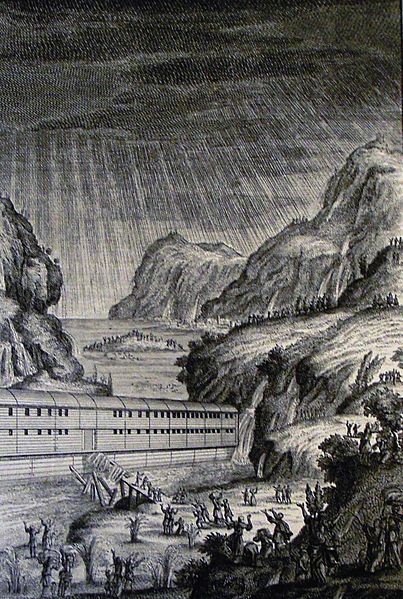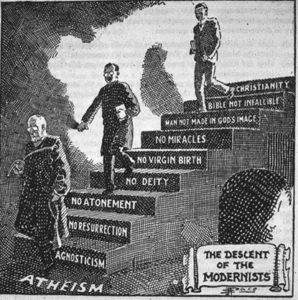All About the Flood
In July of 2016, Answers in Genesis opened the Ark Encounter in northern Kentucky. Ted Davis noted in his article, “Flooding the World with Creationism,” how a so-called “literal” interpretation of the Biblical Flood story was crucial for the view of Scripture held by Answers in Genesis and other young-earth creationists. Woven into their position is the idea of flood geology, namely that fossils are relics of the biblical Flood. This idea was first named and popularized by George McCready Price, a self-taught geologist and author, who claimed that the fossil-bearing rocks seen in the various geologic layers had been produced all at once in a single worldwide flood. But what if flood geology is wrong and there is a more “literal” way to read the Genesis account of the Flood?
Flood geology is one of the foundational beliefs of young earth creationism. Ted Davis noted that “commitment to the YEC duo of a young earth and flood geology remained on the far periphery of conservative Protestantism from the Civil War down to 1961.” In that year Henry Morris and John Whitcomb published The Genesis Flood, which supported Price’s flood geology and eventually birthed the modern young earth creationist (YEC) movement. “Ultimately, then, young-earth creationism is all about the Flood. That’s why AiG built the Ark Encounter.”
The significance of flood geology for young-earth creationism must not be missed: if most fossils were formed in the Flood, then they were not formed through eons of earth history and we cannot draw evolutionary inferences from the fossil record. Thus, the Ark Encounter represents two mightily important things in the minds of creationists. First, the biblical story is literally true—a man named Noah actually constructed a huge wooden boat to save all animal “kinds” from dying in a worldwide flood. Second, the Flood produced the fossils, so we have no scientific evidence that evolution actually happened.
Davis pointed to three threads woven into the YEC understanding of the Genesis Flood story. The first is the biblical understanding of the text. Did a man named Noah actually construct a huge wooden boat in order to save all animal “kinds” from the judgment of a catastrophic worldwide flood? The second thread is scientific. Is there credible scientific evidence to support the claims of flood geology? Are fossils and the geological record explained by a worldwide, catastrophic flood? The third thread pulls at the origins of flood geology and its relationship to a belief in a young earth. Where did they come from and are they peripheral or fundamental to Christian belief and the gospel?
An accumulation of scientific and historical evidence questions whether the biblical Flood account can be taken at face value. Genesis 6-9 clearly describes a global flood that destroyed all humans and land animals except those who were protected in a huge wooden boat built by a man named Noah. However, as BioLogos noted in “How should we interpret the Genesis flood account?” the scientific and historic evidence concludes “there has never been a global flood that covered the entire earth, nor do all modern animals and humans descend from the passengers of a single vessel.” When early geologists (many of whom were Christians) questioned whether the earth was created less than 10,000 years ago, flood geology claimed the earth’s complex geologic record was the result of a violent, global Flood.
So belief in a young earth and flood geology are joined together in the so-called “plain reading of Scripture” promoted by AiG and other young earth creationists. “All other approaches are claimed to require hermeneutical manipulations that ultimately undermine the simple and clear message of the Bible.” Gregg Davidson and Ken Wolgemuth, who are Christian geologists, said the following in “Christian Geologists on Noah’s Flood”:
Flood Geology proponents would have us believe that there is extensive evidence for a violent, earth-wide flood that is apparent if one is willing to consider the possibility. As Christian geologists, we have no philosophical objection to a cataclysmic event of divine origin, and have long been willing to consider evidence of such an event. What we have observed, however, is that evidence for Flood Geology is largely, if not entirely, non-existent. Given the placement and character of sedimentary deposits currently on earth, deposition by a single flood is not only implausible, but utterly impossible unless God temporarily suspended His natural laws in order to establish layers and fossil beds that would subsequently communicate a story vastly different than what actually happened.
Davidson and Wolgemuth presented evidence from salt deposits, tree rings, the fossil record and the sequence of layers in the Grand Canyon that challenges flood geology. YEC counters that these conclusions are the result of human miscalculation and error. Since science is a human endeavor, it is subject to all the errors of humanity, while the Bible is God’s Word. Yet as Longman and Walton commented: “To pit the Bible against science in this fashion is problematic.” They agree with BioLogos: “Because we take God to be the author of the “book of nature” as well as the divine inspirer of the book of Scripture, we believe the proper interpretation of the Flood story will not be in conflict with what we have discovered in the natural world.”
Orthodox Christianity has traditionally affirmed a “two book” view of God’s truth, believing “God reveals himself in both the Bible and in nature.” The study of nature through scientific means it “will never contradict the Bible when both are rightly understood.” While the Bible is true in all it intends to teach us, our interpretations of what it teaches may not be correct. “We need to be open to the possibility that we have wrongly understood a particular passage.” With regard to the Genesis Flood account, is there an interpretative method that does not present us with a forced choice between what the text says and what science tells us?
In their book, The Lost World of the Flood, Tremper Longman and John Walton commented how discussions of the early chapters of Genesis often center on whether the accounts in chapters one through eleven are mythology or history. Framing the question in this way as a dichotomous choice between what is real (history) and what is not real (mythology) not only fails to do justice to the biblical text, it imposes a modern understanding of both mythology and history upon the text.
Today, we often consider the label mythology to imply that what is reported is “not real.” But in the ancient world, they did not consider what we call their mythology to be not real. To the contrary, they believed their mythology to represent the most important reality—deep reality, which transcends what could be reported in terms of events that have transpired in the strictly human realm. Indeed, they further considered that even the events in the human realm, which we might label history, found their greatest significance in aspects of the event that human eyewitnesses could not see—the involvement of the divine hand.
So we should be hesitant to think in such dichotomous terms as history and mythology when reading and interpreting ancient texts. The deepest reality should not be constrained by the limits of human observations of what “actually happened.” The significance of events in Genesis 1-11 is not found in their historicity but in their theology; “not in what happened … but in why it happened.” Israelites in the ancient world did not think about events in the same way we do today. “In the ancient world they viewed reality with an eye to the metaphysical (spiritual) world, and not just through the lens of empiricism.”
The accounts in Genesis 1-11 can be affirmed as having real events as their referents, but the events (yes, they happened) find their significance in the interpretation that they are given in the biblical text. That significance is not found in their historicity but in their theology; not in what happened (or even that something did happen) but in why it happened. What was God doing? That is where the significance is to be found. Our defenses of historicity can become reductionistic if we become too focused on proving the reality of events rather than on embracing the interpretation of the theological significance being traced by the author. The text has no interest in trying to prove the events took place. They assume they did, as do we. Instead they are offering an interpretation that constitutes the divine-human message that carries the authority of the text. Events are not authoritative; the interpretation of the narrator is.
Events, in other words, were more than just history. Seeing events in this way, through a lens that included both the spiritual and the human world, means that categories we moderns might label as mythical overlapped with what we would call the real world. Ancient peoples had a different way of knowing than we moderns do. However, this does not mean their view of events was any less real. In order to understand the Genesis Flood account, we need to understand what it meant to the original audience.
To the extent that the Israelites thought in similar ways, they would not distinguish between these ways of knowing. If such is the case, stating that they consider the flood to be a real event is not as clarifying as we might hope. We cannot draw distinctions about narratives that we are interested in if they do not draw their lines in the same places we do.
We should not impose an interpretation upon the Genesis narrative of the Flood that disregards how the ancient Israelites understood what was being said. The YEC emphasis on the historicity of a global flood fails to recognize that Genesis 1-11 was not written with our scientific world in mind. Its significance lies not in what happened, but why it happened. Longman and Walton put it this way:
Even though the Bible is written for us, it is not written to us. The revelation it provides can equip us to know God, his plan, and his purposes, and therefore to participate with him in the world we face today. But it was not written with our world in mind. In its context, it is not communicated in our language; it is not addressed to our culture; it does not anticipate the questions about the world and its operations that stem from our modern situations and issues.






